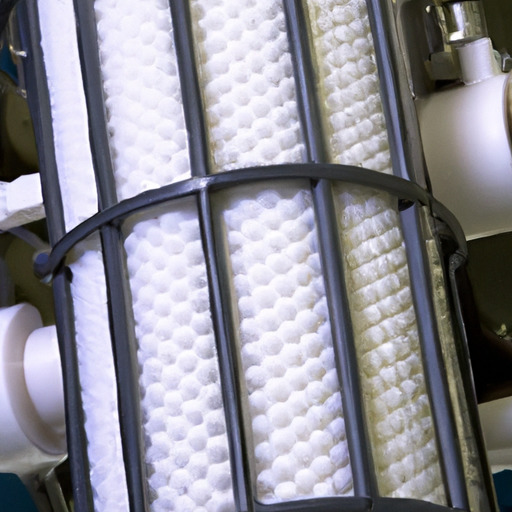Imagine a world where clean and pure water is effortlessly accessible to all. Sounds like a dream, right? Well, with the advent of innovative wastewater treatment solutions, this dream is inching closer to reality. As the global demand for fresh water continues to rise, experts have been tirelessly working on finding sustainable and efficient ways to treat wastewater. These groundbreaking technologies not only ensure the conservation of this precious resource but also offer potential solutions to one of the most pressing environmental challenges of our time. In this article, we will explore some of the most exciting advancements in wastewater treatment that have the potential to revolutionize the way we manage and utilize water resources. Get ready to be amazed by the incredible possibilities that lie ahead.
Overview
Wastewater treatment is an essential process that plays a vital role in maintaining a healthy and sustainable environment. It involves the removal of contaminants and pollutants from wastewater, making it safe to be discharged back into the environment or reused for various purposes. With the increasing pressure on our water resources and the growing concerns about pollution, it is crucial to prioritize wastewater treatment to prevent adverse impacts on ecosystems and human health.
Importance of wastewater treatment
Wastewater treatment is of paramount importance because it helps to protect the environment and safeguard public health. By removing contaminants such as pathogens, chemicals, and nutrients from wastewater, treatment plants prevent the contamination of water bodies, ensuring the availability of clean water for drinking, recreation, and aquatic life. Additionally, wastewater treatment is crucial for preventing the spread of waterborne diseases and reducing water pollution, contributing to a healthier and safer community.
Current challenges in wastewater treatment
Despite its importance, wastewater treatment faces several challenges in today’s world. One of the major challenges is the increasing volume of wastewater due to population growth and urbanization. This puts a strain on the existing infrastructure and requires innovative approaches to handle the sheer quantity of wastewater generated. Moreover, contaminants of emerging concern, such as pharmaceuticals and microplastics, pose new challenges in wastewater treatment as they are not effectively removed by conventional treatment methods. These challenges highlight the need for innovative solutions in wastewater treatment.
Need for innovative solutions
To address the current challenges in wastewater treatment and ensure its sustainability in the future, there is a need for innovative solutions. Innovative technologies, processes, and systems can enhance the efficiency of wastewater treatment, improve resource recovery, and minimize the environmental impact. These solutions can also help to optimize operation and maintenance, reduce energy consumption, and promote cost-effectiveness. By embracing innovation in wastewater treatment, we can create a cleaner and greener future for generations to come.
Emerging Technologies
In recent years, several emerging technologies have gained attention for their potential in wastewater treatment. These technologies offer promising solutions to enhance the efficiency and effectiveness of the treatment process.
Membrane bioreactors
Membrane bioreactors (MBRs) combine biological treatment with membrane filtration to achieve high-quality effluent. The use of membranes eliminates the need for conventional settling tanks, resulting in a smaller footprint and improved solid-liquid separation. MBRs can effectively remove suspended solids, bacteria, and viruses from wastewater, improving the overall treatment efficiency. The high-quality effluent produced by MBRs makes it suitable for various applications, including recycling for non-potable purposes.
Advanced oxidation processes
Advanced oxidation processes (AOPs) involve the use of powerful oxidants to degrade and remove contaminants in wastewater. These processes generate highly reactive hydroxyl radicals, which can break down complex organic compounds and recalcitrant pollutants that are not easily biodegradable. AOPs have proven effective in removing persistent organic pollutants, pharmaceuticals, and endocrine-disrupting compounds, thereby improving the overall water quality. These processes can be combined with other treatment methods to achieve optimized results.
Anaerobic digestion
Anaerobic digestion is a biological process that converts organic matter in wastewater into biogas and biosolids. It operates in the absence of oxygen and relies on the activity of anaerobic bacteria to break down organic compounds. Anaerobic digestion not only treats the wastewater but also produces renewable energy in the form of biogas, which can be used for heating, electricity generation, or even as a transportation fuel. The biosolids generated during the process can be further processed into nutrient-rich fertilizers, closing the loop and promoting resource recovery.
Resource Recovery
Wastewater treatment not only aims to remove contaminants from wastewater but also offers opportunities for resource recovery. Innovative approaches in resource recovery can help to reduce reliance on scarce natural resources and create a sustainable circular economy.
Extracting energy from wastewater
Wastewater contains a significant amount of organic matter that can be converted into energy. Technologies such as anaerobic digestion and microbial fuel cells harness the energy potential of wastewater by utilizing the organic matter to produce biogas or generate electricity. This energy can be used to power wastewater treatment plants or even injected into the grid for wider use. By extracting energy from wastewater, we can reduce our carbon footprint and contribute to a more sustainable energy future.
Recycling water for agricultural use
Water scarcity is a global concern, and finding alternative sources of water for irrigation is crucial for food production. Wastewater, after appropriate treatment, can be recycled and used for agricultural purposes. Advanced treatment methods, such as reverse osmosis and disinfection, can produce high-quality water that meets the required standards for irrigation. This not only conserves freshwater resources but also reduces the demand for chemical fertilizers, as treated wastewater often contains valuable nutrients that can be beneficial for plant growth.
Recovering valuable resources
Wastewater contains valuable resources such as nitrogen, phosphorus, and metals, which can be recovered and reused. Phosphorus, in particular, is a finite resource that is essential for agriculture, yet it is becoming increasingly scarce. Technologies like struvite precipitation and nutrient recovery systems allow for the extraction of valuable nutrients from wastewater, which can then be used as fertilizers or feedstock for various industries. By recovering valuable resources from wastewater, we can create a more sustainable and circular economy.
Decentralized Systems
Traditional centralized wastewater treatment systems require extensive infrastructure and are often not feasible for rural or remote areas. Decentralized systems offer a viable alternative by providing small-scale treatment options that can meet the specific needs of different communities.
Small-scale treatment options
Small-scale treatment options are designed to treat wastewater on a smaller scale, catering to the needs of individual households or small communities. Technologies such as septic tanks, package plants, and constructed wetlands can effectively treat wastewater from a small number of sources. These systems are relatively simple in design and operation, making them suitable for areas without access to centralized wastewater treatment facilities.
On-site wastewater treatment
On-site wastewater treatment involves the treatment of wastewater at the point of generation, typically within individual homes or buildings. Technologies such as aerobic treatment units and recirculating sand filters can treat wastewater on-site, allowing for the safe disposal or reuse of the treated effluent. On-site treatment systems eliminate the need for extensive sewer networks and can be more cost-effective and environmentally friendly in certain situations.
Community-level solutions
In some cases, decentralized wastewater treatment systems can be implemented at the community level, serving multiple households or small neighborhoods. These systems can be designed based on the specific needs and conditions of the community, utilizing technologies such as decentralized membrane bioreactors or sequencing batch reactors. Community-level solutions provide a more cost-effective and efficient way to treat wastewater, particularly in areas with scattered or low population density.
Smart Monitoring and Control
Advancements in technology have paved the way for smart monitoring and control systems in wastewater treatment. These systems offer real-time monitoring, predictive analytics, and automated control, enhancing the efficiency and reliability of the treatment process.
Real-time monitoring of treatment processes
Real-time monitoring systems allow for continuous monitoring of key parameters in the wastewater treatment process. Sensors and instruments measure variables such as pH, dissolved oxygen, temperature, and turbidity, providing instant feedback on the performance of the treatment plant. This real-time data enables operators to identify any deviations from desired conditions and take corrective actions promptly, ensuring optimal treatment efficiency.
Predictive analytics for system optimization
Predictive analytics utilizes algorithms and data analysis to predict the behavior and performance of wastewater treatment systems. By analyzing historical data and real-time measurements, predictive models can anticipate potential issues, optimize process control, and improve resource allocation. These models can also help in predicting future trends and demands, allowing operators to plan and optimize operations accordingly. Predictive analytics aid in achieving better efficiency, reducing operational costs, and enhancing the overall performance of wastewater treatment plants.
Automated control systems
Automated control systems integrate real-time monitoring and predictive analytics to automate the control of various processes in wastewater treatment. These systems use algorithms and programming to adjust the operation of pumps, valves, and other equipment based on the data collected and analyzed. By automating control, operators can achieve better process stability, minimize human error, and optimize energy usage. Automated control systems improve operational efficiency and reliability while reducing the reliance on manual intervention.
Green Infrastructure
Green infrastructure refers to the use of natural and ecologically-friendly techniques in managing stormwater and wastewater. By incorporating green infrastructure practices in wastewater treatment, we can enhance the overall sustainability and resilience of our communities.
Constructed wetlands
Constructed wetlands mimic natural wetland ecosystems to treat wastewater through a combination of biological, chemical, and physical processes. These wetlands are designed to promote the growth of wetland plants, which help in the removal of pollutants through processes such as uptake, filtration, and microbial degradation. Constructed wetlands effectively remove nutrients, pathogens, and organic matter from wastewater while providing additional benefits such as habitat creation, water retention, and aesthetic value.
Rooftop gardens and rainwater harvesting
Rooftop gardens and rainwater harvesting systems are innovative ways to manage stormwater runoff and reduce the burden on wastewater treatment plants. Vegetated rooftops absorb and retain rainwater, reducing the volume of stormwater entering the sewer system. Rainwater harvesting systems capture and store rainwater for later use, reducing the demand for fresh water. These green infrastructure practices promote sustainable water management, minimize urban heat island effects, and enhance the visual appeal of buildings.
Permeable pavements
Permeable pavements are designed to allow stormwater to infiltrate into the ground rather than runoff into the sewer system. These pavements are made of porous materials that enable the passage of water, reducing the volume and velocity of stormwater runoff. Permeable pavements effectively capture and filter pollutants, improving water quality and reducing the strain on wastewater treatment plants. Additionally, they help in replenishing groundwater and mitigate the risk of flooding in urban areas.
Nano and Micro Technologies
Nano and micro technologies offer innovative approaches to addressing specific challenges in wastewater treatment. These technologies utilize the unique properties of nano and micro-scale materials to remove pollutants and improve overall treatment efficiency.
Nanomaterials for pollutant removal
Nanomaterials, such as nanoparticles and nanofibers, have shown great potential in removing pollutants from wastewater. These materials have a large surface area and high reactivity, allowing them to effectively adsorb or catalytically degrade pollutants. Nanomaterial-based technologies offer advantages such as high removal efficiency, rapid kinetics, and the ability to target specific contaminants. However, further research is needed to evaluate the potential environmental impacts and ensure the safe use of these materials.
Microbial fuel cells
Microbial fuel cells (MFCs) utilize the metabolic activity of microorganisms to generate electricity from organic matter in wastewater. These fuel cells harvest the electrons released during microbial metabolism and convert them into electrical energy. MFCs not only treat wastewater but also produce renewable energy, making them a sustainable and resource-efficient technology. While MFCs are still in the early stages of development, they show great promise for decentralized and low-cost wastewater treatment.
Nano sensors for water quality monitoring
Nano sensors offer a new frontier in water quality monitoring, enabling real-time and accurate measurement of various parameters in wastewater. These sensors utilize nanotechnology to detect and analyze contaminants, nutrients, and other essential variables in situ. Nano sensors provide continuous monitoring, immediate detection of water quality deviations, and cost-effective solutions compared to traditional sampling and laboratory analysis. The development and implementation of nano sensors can greatly enhance the efficiency and effectiveness of wastewater treatment processes.
Electrochemical Treatment
Electrochemical treatment methods leverage electrical energy to enhance various aspects of wastewater treatment. These methods offer advantages such as high removal efficiency, low energy consumption, and the potential for resource recovery.
Electrocoagulation
Electrocoagulation involves the use of an electric current to destabilize pollutants and facilitate their removal from wastewater. The process relies on the coagulation and flocculation of contaminants, which can then be effectively separated through sedimentation or filtration. Electrocoagulation is particularly useful for the removal of suspended solids, metals, and organic pollutants. It offers a cost-effective and sustainable alternative to conventional chemical coagulation methods, reducing the need for chemical additives and minimizing environmental impact.
Electrolysis
Electrolysis is a process that uses an electric current to induce electrochemical reactions in wastewater. It can be employed for the removal of contaminants such as organic compounds, nutrients, and heavy metals. Electrolysis can facilitate the oxidation or reduction of target pollutants, leading to their transformation into less harmful or easier to remove forms. In addition to contaminant removal, electrolysis offers potential for energy recovery through the production of hydrogen or other valuable byproducts.
Electrodialysis
Electrodialysis utilizes an electric field to selectively remove ions from wastewater through ion exchange membranes. By applying a voltage difference across the membrane stack, positively charged ions can be transported to one side, while negatively charged ions move to the other side. Electrodialysis is effective in the removal of salts, heavy metals, and other dissolved ions. It can be used for the desalination of wastewater, the recovery of valuable ions, or the adjustment of the ionic composition for specific industrial processes.
Innovative Biological Processes
Biological processes play a crucial role in wastewater treatment by harnessing the inherent abilities of microorganisms to degrade and remove pollutants. Innovative biological processes further enhance these natural abilities to achieve sustainable and efficient treatment.
Algae-based treatment systems
Algae-based treatment systems harness the photosynthetic activity of algae to remove nutrients and contaminants from wastewater. Algae utilize nutrients such as nitrogen and phosphorus as a source of growth, effectively reducing their concentration in the wastewater. Furthermore, algae can facilitate the removal of organic matter and the production of oxygen through photosynthesis. Algae-based treatment systems offer advantages such as energy production through algal biomass, carbon sequestration, and potential for valuable byproducts such as biofuels and bioplastics.
Biofilm reactors
Biofilm reactors utilize the formation of microbial biofilms to enhance the treatment of wastewater. Biofilms consist of microorganisms that attach to a surface and form a matrix of extracellular polymeric substances. These biofilms provide a protected and stable environment for microbial communities, allowing for the degradation of organic matter and the removal of pollutants. Biofilm reactors offer advantages such as high treatment efficiency, reduced footprint, and the potential for simultaneous removal of multiple contaminants.
Biological nutrient removal
Biological nutrient removal (BNR) processes are designed to remove excess nitrogen and phosphorus from wastewater, addressing one of the major causes of water pollution. BNR processes rely on specific groups of bacteria that can convert nitrogen and phosphorus into gas forms or accumulate them in biomass. By controlling the environmental conditions and optimizing the microbial community, BNR processes can achieve high removal efficiency for nutrients. These processes contribute to improved water quality, reduced eutrophication, and protection of aquatic ecosystems.
International Case Studies
Several international case studies demonstrate successful implementation of innovative wastewater treatment solutions, showcasing the potential and effectiveness of these technologies in real-world scenarios.
Singapore’s NEWater
Singapore’s NEWater is a groundbreaking water reclamation project that has revolutionized wastewater treatment in the city-state. The NEWater process involves multiple steps, including microfiltration, reverse osmosis, and advanced oxidation, to produce ultra-pure water from highly treated wastewater. This reclaimed water is then used for various non-potable applications such as industrial processes, landscaping, and even indirect drinking water supply. The NEWater project has not only strengthened Singapore’s water resilience but also set an example for other countries facing water scarcity.
Rotterdam’s water square
Rotterdam, known for its innovative approach to urban water management, has implemented an ingenious solution to manage stormwater and reduce the risk of flooding. The city’s water square, located in the Benthemplein area, serves as a public space that can hold excess rainwater during heavy rainfall events. The square features permeable pavements, green roofs, and underground storage facilities to capture and store stormwater runoff. This innovative design not only reduces the strain on the sewer system but also creates an attractive and functional green space for the community.
Decentralized systems in India
In India, decentralized wastewater treatment systems have emerged as a viable solution to cater to the needs of remote or underserved communities. The Integrated Wastewater Centres (IWCs) implemented in the city of Nagpur are a prime example of such systems. These IWCs utilize decentralized technologies such as anaerobic digestion, constructed wetlands, and decentralized membrane bioreactors to treat wastewater from households and industries. The treated effluent is then recycled for agricultural irrigation, relieving pressure on freshwater resources and improving the livelihoods of farmers in the region.
In conclusion, wastewater treatment is a critical undertaking that needs to be prioritized for a sustainable future. The current challenges and growing concerns call for innovative solutions in wastewater treatment. Emerging technologies, resource recovery, decentralized systems, smart monitoring and control, green infrastructure, nano, and micro technologies, electrochemical treatment, innovative biological processes, and international case studies showcase the vast potential for transformation in wastewater treatment. By embracing these innovative approaches, we can ensure the availability of clean water, protect the environment, and create a more sustainable and resilient future.



